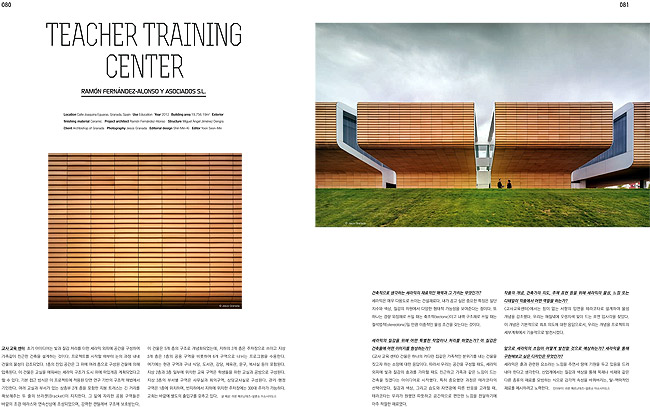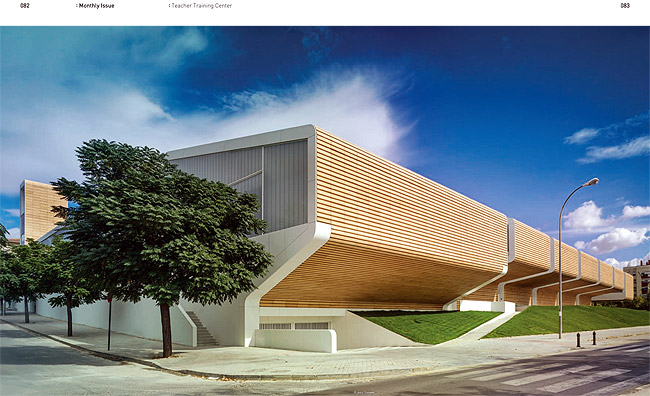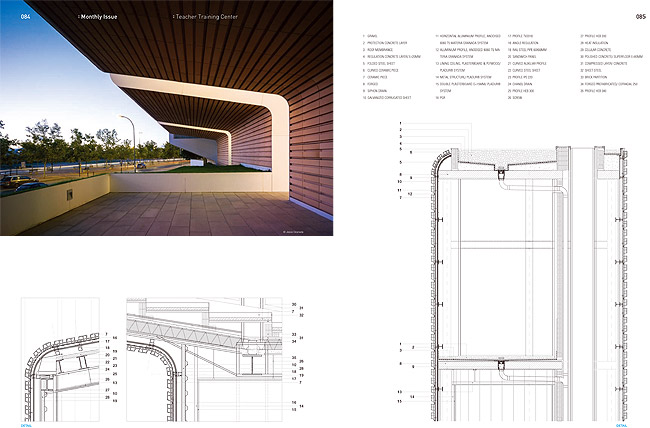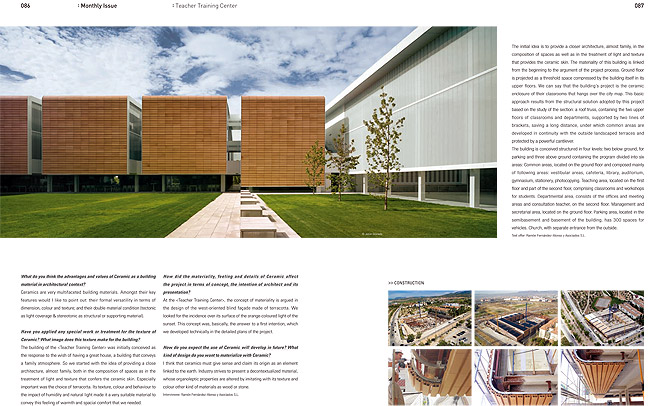Teacher Training Center
Ramon Fernandez-Alonso y Asociados S.L.




교사 교육 센터 초기 아이디어는 빛과 질감 처리를 더한 세라믹 외피에 공간을 구성하여 가족같이 친근한 건축을 설계하는 것이다. 프로젝트를 시작할 때부터 논의 과정 내내 건물의 물성이 강조되었다. 1층의 진입 공간은 그 위에 여러 층으로 구성된 건물에 의해 압축된다. 이 건물은 교실을 에워싸는 세라믹 구조가 도시 위에 떠있게끔 계획되었다고 할 수 있다. 기본 접근 방식은 이 프로젝트에 적용된 단면 연구 기반의 구조적 해법에서 기인한다. 여러 교실과 부서가 있는 상층부 2개 층을 포함한 지붕 트러스는 긴 거리를 확보해주는 두 줄의 브라켓(Bracket)이 지지한다. 그 밑에 자리한 공용 구역들은 바깥의 조경 테라스와 연속선상에 조성되었으며, 강력한 캔틸레버 구조에 보호받는다. 이 건물은 5개 층의 구조로 개념화되었는데, 지하의 2개 층은 주차장으로 쓰이고 지상 3개 층은 1층의 공용 구역을 비롯하여 6개 구역으로 나뉘는 프로그램을 수용한다. 여기에는 현관 구역과 구내 식당, 도서관, 강당, 체육관, 문구, 복사실 등이 포함된다. 지상 2층과 3층 일부에 위치한 교육 구역은 학생들을 위한 교실과 공방으로 구성된다. 지상 3층의 부서별 구역은 사무실과 회의구역, 상담교사실로 구성된다. 관리?행정 구역은 1층에 위치하며, 반지하에서 지하에 위치한 주차장에는 300대 주차가 가능하다. 교회는 바깥에 별도의 출입구를 갖추고 있다.
글 제공: 라몬 페르난데즈-알론소 아소시아도스
건축적으로 생각하는 세라믹의 재료적인 매력과 그 가치는 무엇인가? 세라믹은 매우 다용도로 쓰이는 건설재료다. 내가 꼽고 싶은 중요한 특징은 일단 치수와 색상, 질감의 차원에서 다양한 형태적 가능성을 보여준다는 점이다. 또 하나는 경량 외장재로 쓰일 때는 축조적(tectonic)이고 내력 구조재로 쓰일 때는 절석법적(stereotonic)일 만큼 이중적인 물성 조건을 갖는다는 것이다. 세라믹의 질감을 위해 어떤 특별한 작업이나 처리를 하였는가? 이 질감은 건축물에 어떤 이미지를 형성하는가? <교사 교육 센터> 건물은 하나의 커다란 집같은 가족적인 분위기를 내는 건물을 짓고자 하는 소망에 대한 응답이다. 따라서 우리는 공간을 구성할 때도, 세라믹 외피에 빛과 질감의 효과를 가미할 때도 친근하고 가족과 같은 느낌이 드는 건축을 짓겠다는 아이디어로 시작했다. 특히 중요했던 과정은 테라코타의 선택이었다. 질감과 색상, 그리고 습도와 자연광에 따른 반응을 고려할 때, 테라코타는 우리가 원했던 따뜻하고 공간적으로 편안한 느낌을 전달하기에 아주 적절한 재료였다. 작품의 개념, 건축가의 의도, 주제 표현 등을 위해 세라믹의 물성, 느낌 또는 디테일이 작품에서 어떤 역할을 하는가? <교사교육센터>에서는 창이 없는 서향의 입면을 테라코타로 설계하여 물성 개념을 강조했다. 우리는 해질녘에 오렌지색 빛이 드는 표면 입사각을 찾았다. 이 개념은 기본적으로 최초 의도에 대한 응답으로서, 우리는 개념을 프로젝트의 세부계획에서 기술적으로 발전시켰다. 앞으로 세라믹의 쓰임이 어떻게 발전할 것으로 예상하는가? 세라믹을 통해 구현해보고 싶은 디자인은 무엇인가? 세라믹은 흙과 관련된 요소라는 느낌을 주면서 땅에 기원을 두고 있음을 드러 내야 한다고 생각한다. 산업계에서는 질감과 색상을 통해 목재나 석재와 같은 다른 종류의 재료를 모방하는 식으로 감각적 속성을 바꿔버리는, 탈-맥락적인 재료를 제시하려고 노력한다.
인터뷰이: 라몬 페르난데즈-알론소 아소시아도스
The initial idea is to provide a closer architecture, almost family, in the composition of spaces as well as in the treatment of light and texture that provides the ceramic skin. The materiality of this building is linked from the beginning to the argument of the project process. Ground floor is projected as a threshold space compressed by the building itself in its upper floors. We can say that the building’s project is the ceramic enclosure of their classrooms that hangs over the city map. This basic approach results from the structural solution adopted by this project based on the study of the section: a roof truss, containing the two upper floors of classrooms and departments, supported by two lines of brackets, saving a long distance, under which common areas are developed in continuity with the outside landscaped terraces and protected by a powerful cantilever. The building is conceived structured in four levels: two below ground, for parking and three above ground containing the program divided into six areas: Common areas, located on the ground floor and composed mainly of following areas: vestibular areas, cafeteria, library, auditorium, gymnasium, stationery, photocopying. Teaching area, located on the first floor and part of the second floor, comprising classrooms and workshops for students. Departmental area, consists of the offices and meeting areas and consultation teacher, on the second floor. Management and secretarial area, located on the ground floor. Parking area, located in the semibasement and basement of the building, has 300 spaces for vehicles. Church, with separate entrance from the outside.
Text offer: Ramon Fernandez-Alonso y Asociados S.L.
What do you think the advantages and values of Ceramic as a building material in architectural context? Ceramics are very multifaceted building materials. Amongst their key features would I like to point out: their formal versatility in terms of dimension, colour and texture; and their double material condition (tectonic as light coverage & stereotonic as structural or supporting material). Have you applied any special work or treatment for the texture of Ceramic? What image does this texture make for the building? The building of the (Teacher Training Center) was initially conceived as the response to the wish of having a great house, a building that conveys a family atmosphere. So we started with the idea of providing a close architecture, almost family, both in the composition of spaces as in the treatment of light and texture that confers the ceramic skin. Especially important was the choice of terracotta. Its texture, colour and behaviour to the impact of humidity and natural light made it a very suitable material to convey this feeling of warmth and spacial comfort that we needed. How did the materiality, feeling and details of Ceramic affect the project in terms of concept, the intention of architect and its presentation? At the (Teacher Training Center), the concept of materiality is argued in the design of the west-oriented blind facade made of terracotta. We looked for the incidence over its surface of the orange-coloured light of the sunset. This concept was, basically, the answer to a first intention, which we developed technically in the detailed plans of the project. How do you expect the use of Ceramic will develop in future? What kind of design do you want to materialize with Ceramic? I think that ceramics must give sense and claim its origin as an element linked to the earth. Industry strives to present a decontextualized material, whose organoleptic properties are altered by imitating with its texture and colour other kind of materials as wood or stone.
Interviewee: Ramon Fernandez-Alonso y Asociados S.L.
건축문화 2016년 7월호 [Monthly Issue]페이지 © 에이엔씨출판(주)